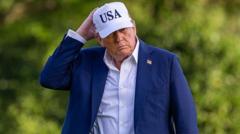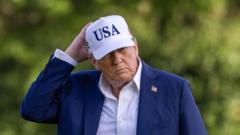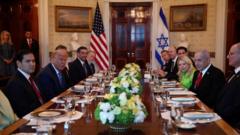As President Trump's promises of quick trade agreements fade, the extension from July 1 to August 1 signals an uncertain economic landscape and rising tension among trading partners.
Trump Postpones Tariffs as Global Trade Tensions Escalate

Trump Postpones Tariffs as Global Trade Tensions Escalate
In a surprising move, the Trump administration has once again delayed the imposition of tariffs, further complicating international trade negotiations.
In a notable reversal of expectations, President Trump has postponed the implementation of tariffs that were initially set to take effect this week. The announcement rolled back on the administration’s ambitious commitment to strike "90 deals in 90 days," illustrating its growing struggle to navigate the complexities of global trade dynamics. The new deadline of August 1 may not be the final word, as further extensions appear likely.
Treasury Secretary Scott Bessent emphasized the administration's focus on the eighteen countries that contribute to 95% of the U.S. trade deficit. However, despite the U.S. pushing for negotiations, the letters dispatched to trading partners merely reiterated previously established tariff rates, offering little in terms of new concessions. The lack of tangible progress suggests a weakness in the administration's negotiating strategy.
Responses from countries like Japan and South Korea have been frank, with Japan’s finance minister hinting at leveraging its significant holding of U.S. government debt against America's trade policies. As other nations adopt retaliatory measures, U.S. retailers are voicing concerns about potential price hikes and product shortages if trade tensions escalate.
Financial markets display an air of skepticism, increasingly believing that the Trump administration may backtrack on its hardline measures. This uncertainty is compounded by falling U.S. exports to China, with a striking 9.7% decrease this year, while Chinese exports to other regions, including the UK and Africa, have surged.
Despite the heightened tariffs, expected to exceed previous rates significantly, U.S. Treasury revenues from these tariffs have reached record highs. However, this trade isolation is prompting other countries to solidify their economic partnerships, evidenced by recent trade deals between India and the UK, as well as between the EU and Canada.
As the effective tariff rate imposed by the U.S. climbs to approximately 15%, double the historical average, the long-term effects on both the American economy and its trade relationships remain to be seen. Observers maintain a wary eye on market reactions, anticipating that the current calm may not persist amid rising global trade tensions.
Treasury Secretary Scott Bessent emphasized the administration's focus on the eighteen countries that contribute to 95% of the U.S. trade deficit. However, despite the U.S. pushing for negotiations, the letters dispatched to trading partners merely reiterated previously established tariff rates, offering little in terms of new concessions. The lack of tangible progress suggests a weakness in the administration's negotiating strategy.
Responses from countries like Japan and South Korea have been frank, with Japan’s finance minister hinting at leveraging its significant holding of U.S. government debt against America's trade policies. As other nations adopt retaliatory measures, U.S. retailers are voicing concerns about potential price hikes and product shortages if trade tensions escalate.
Financial markets display an air of skepticism, increasingly believing that the Trump administration may backtrack on its hardline measures. This uncertainty is compounded by falling U.S. exports to China, with a striking 9.7% decrease this year, while Chinese exports to other regions, including the UK and Africa, have surged.
Despite the heightened tariffs, expected to exceed previous rates significantly, U.S. Treasury revenues from these tariffs have reached record highs. However, this trade isolation is prompting other countries to solidify their economic partnerships, evidenced by recent trade deals between India and the UK, as well as between the EU and Canada.
As the effective tariff rate imposed by the U.S. climbs to approximately 15%, double the historical average, the long-term effects on both the American economy and its trade relationships remain to be seen. Observers maintain a wary eye on market reactions, anticipating that the current calm may not persist amid rising global trade tensions.





















